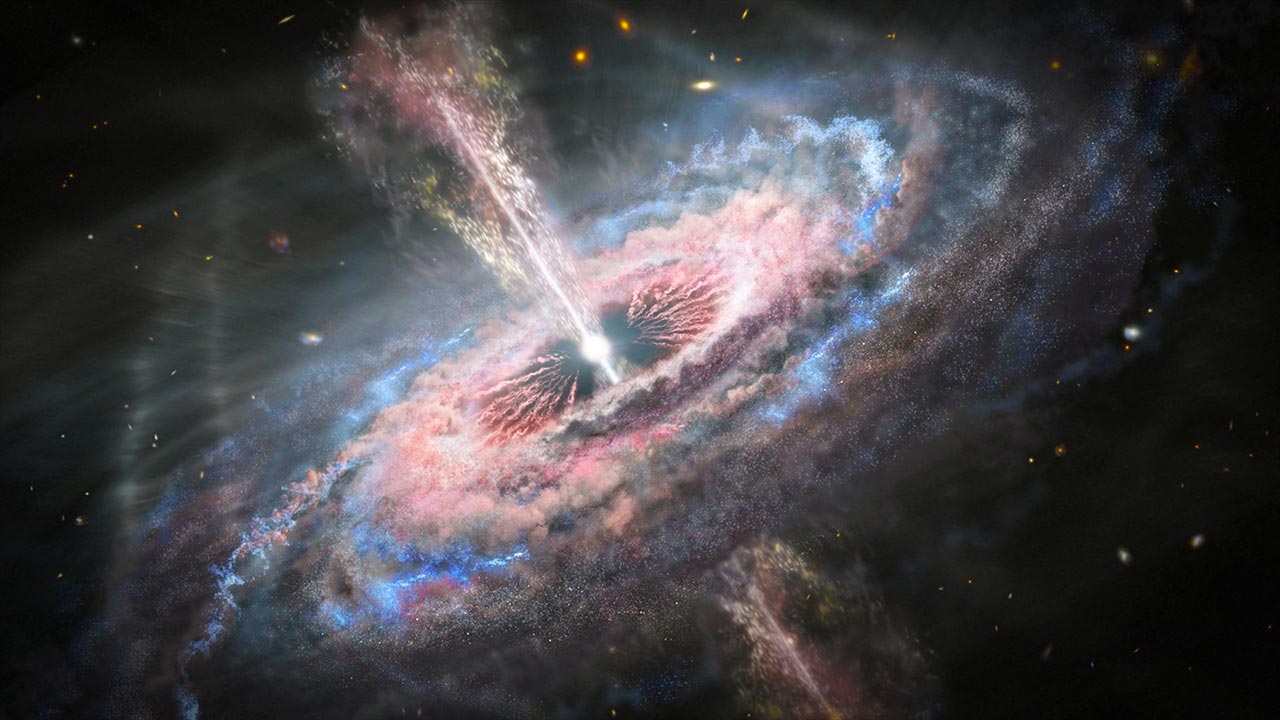

The black hole surrounded by bright glowing gas is what we call a quasar.
Quasar galaxy full#
This produces extreme heat that makes the gas around the black hole glow brighter than an entire galaxy full of stars. The gas falling into the black hole goes faster and faster the closer it gets. Measurements like that show that quasars are very massive black holes surrounded by hot gas that is being pulled into the black hole by the hole's enormous gravity. We study them with large telescopes, like the ones at the Keck Observatory on the summit of Mauna Kea in Hawaii. They are brighter than 100 billion stars like our Sun, but so far away that they appear very faint in our nighttime sky. Part 1 Quasars are mysterious astronomical objects. Primary Place of Performance Congressional District:
Frederick Hamann (Principal Investigator) Sponsored Research Office:. Pesce (703)292-7373 AST Division Of Astronomical Sciences MPS Direct For Mathematical & Physical Scien REGENTS OF THE UNIVERSITY OF CALIFORNIA AT RIVERSIDE West in the September 10th issue of the Astrophysical Journal.Red Quasars and Quasar/Galaxy Evolution NSF Org: More details can be found in the paper " Searching High Redshift Large-Scale Structures: Photometry of Four Field Around Quasar Pairs at z~1" by N.V. The team is already analyzing spectra of the galaxies around QP0110-0219 and these results confirm their earlier findings. The next step will be to further confirm the presence of the clusters of galaxies around these four quasar pairs by measuring redshifts of galaxies in the fields. This discovery suggests that quasar pairs are excellent tracers of dense environments at z ~ 1 and that this same technique might be useful for identifying clusters at even higher redshifts. These results indicate that QP0110-0219 is indeed in a rich cluster. Moreover, Boris and collaborators verified that this quasar pair has been serendipitously detected in X-ray and the observed X-ray flux is consistent with emission from quasars and a possible cluster around them. The reddest galaxies appear to have a filamentary-like distribution, typical of clusters in the process of formation. Quantitative analysis of the GMOS image reveals a large excess of galaxies comparable to that found in massive clusters of galaxies at low redshifts. Figure 1 shows the field around the quasar pair QP0110-0219, the richest of the four fields studied. The GMOS images reveal an overabundance of galaxies in the vicinity of each quasar pair, with three of the four quasar pairs probably residing in rich galaxy clusters. Examination of the quasar spectra confirmed that these are bona fide pairs of quasars rather than gravitationally lensed systems. The quasar pairs were selected to have redshift differences smaller than 0.01 and projected angular separations less than 300 arcseconds, corresponding to projected physical separations less than 2.5 megaparsecs. If, as evidence suggests, their spatial distribution follows that of galaxies then the presence of two or more quasars in the same small volume of space might indicate a region that is exceptionally rich in galaxies.ĭeep multi-color images of four fields around quasar pairs (QP0110-0219, QP1310+0007, QP1355-0032, and QP0114-3140) at redshift z~1 were obtained with the Gemini Multi-Object Spectrograph (GMOS) at both Gemini North and South. Quasars are relatively rare astronomical objects. Gemini In The Era of Multi-Messenger Astronomyįigure 1: Field around quasar pair (circled) QP0110-0219.Īn international team of researchers led by Natalia Boris of the University of São Paulo in Brazil has shown that quasar pairs may be excellent beacons for finding clusters of galaxies in the early universe. 
Gemini Telescopes, Science and Technologies.Timing information in Gemini Instruments.






 0 kommentar(er)
0 kommentar(er)
